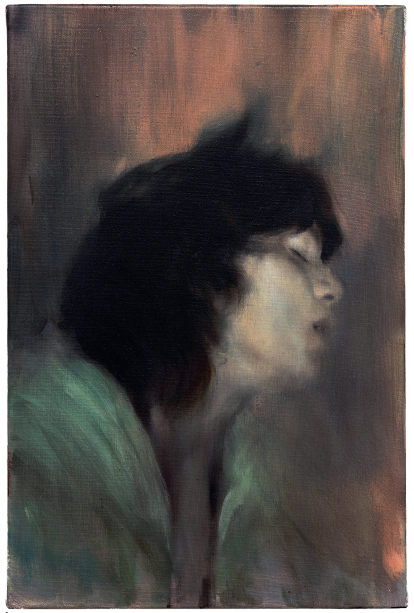Paul P.
When I think of Paul P.’s portraits, I think of a tilt of the head. Slightly off to one side, a gaze cast down or tilted up to the sky—neck outstretched and accessible. How do these postures articulate the space between shame and pride? Performed chasteness, a head down and eyes averted from the camera, works in erotic imagery as performed shame, played for the benefit of the viewer. Paul P.’s act of rendering models from gay erotic magazines, in the style of 19th-century art, becomes a performance itself. In appropriating the images, new meaning forms. The portraits and corresponding abstractions and colour studies exist within a kind of purgatory. There’s a sensation of floating while looking at the work, thanks to the in-between qualities of visibility/ invisibility, stigma/pride, low brow/high brow, contrast/ monotone and implicit/explicit desire.

Paul P., Untitled, 2010, oil on canvas, 16.1 x 10.6 inches. Courtesy the artist and Cooper Cole, Toronto.
“Each countenance is selected from the multitudes of young men implicated in the then-outlaw publications because they appear to possess the look and feel of art,” Paul P. wrote in the exhibition text for his recent exhibition, “Gamboling Green,” at Cooper Cole in Toronto. “Their portraits are then systematically rendered along modes of late nineteenth century painting and drawing; another tenuous period of aesthetic energy wherein homosexuality transformed from an act into a personality.” Superimposing images from archival magazines within the context of art history cultivates a conversation between the historical past (19th-century painting), the contemporary past (photographs from gay erotic magazines in the 20th century) and the present (the act of painting). In combining these different periods, Paul P. shifts the meaning of the gaze away from the context in which it was created and projects an updated role onto the subjects—and the viewer. In short, Paul P. removes the dust of time.


Both images: Installation view, “Gamboling Green,” 2020, Cooper Cole, Toronto. Courtesy the artist and Cooper Cole.
He notes the paradox of invisibility and visibility in his work in the exhibition text. “Invisibly visible, unlocatably everywhere: if the gay presence is threatened by absence, it is not only because of the secret (or not so secret) intentions of those who are fascinated by gays, or even the result of the devastating work of AIDS, but also because gays have been de-gaying themselves in the process of making themselves visible.” This is the artist quoting queer theorist Leo Bersani. The portraits, the apex of visibility in the show, are a compilation of the abstractions and colour studies— both of which exist in the realm of invisibility. The abstractions, fields of vibrant colours shifting into darkness, are reminiscent of thresholds: doorways or windows. The colour studies are compounded of layer upon layer of colour, visible only when viewed from the side. The tactile elements of paint in both the abstractions and colour studies ask the question: What is under the surface of the portraits?
Implicit and explicit desire converge in Paul P.’s work to create portraits that are soft and erotic—the contradiction creating a sense of an uncanny valley where the figure feels familiar and unfamiliar at the same time (as do Paul P.’s abstracted paintings of Venice). As theorist Silvan Tomkins writes about shame, “one is suddenly looked at by one who is strange, or … one wishes to look at or commune with another person but suddenly cannot because he is strange, or one expected him to be familiar but he suddenly appears unfamiliar, or one started to smile but found one was smiling at a stranger.” If the downcast gaze of the models is a performed affect, this role is transferred to the viewer by the confused states of knowing and unknowing present on the canvas. You can’t really be sure what you’re looking at. ❚
“Gamboling Green” was exhibited at Cooper Cole, Toronto, from August 26 to October 3, 2021.
Tatum Dooley is a writer and curator based in Toronto. Her work has appeared in Artforum, Canadian Art, Garage Magazine, the Globe and Mail, Lapham’s Quarterly, The Walrus and more. She is the founder of Canadian Art Forecast.

